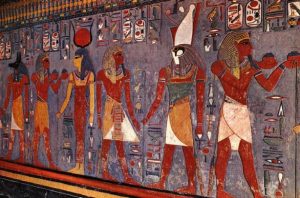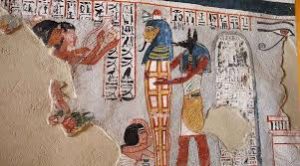
Before coming to the throne himself, Horemheb had served in the court of King Amenhotep IV, then he had continued in his post under the reign of King Tutankhamun and finally under the command of King Ay. His tomb, discovered in February, 1908 by the young British Egyptologist Edward Ayrton who worked under the orders of Theodore Davis, was damaged during a rainstorm in the Valley of the Kings in 1996 and has since been closed for repairs. Tomb KV 57 is remarkably well-preserved, and its decorations are some of the most important in the Valley of the Kings. It is 128 meters long and covers over 473 square metes. This tomb marks a transition between earlier tombs, whose axes made a right-angle turn, and the straight-line, single-axis tombs of the later New Kingdom.
- Architecture and Decoration of the Tomb of Horemheb (KV 57)
The first four corridors of the Tomb of Horemheb are not decorated. Well Chamber E is the first decorated part of Tomb KV 57, and its walls are covered with carved figures painted on a blue-grey background. It was the first royal tomb decorated in painted raised relief instead of paintings on flat, plastered surfaces. In Well Chamber E, the colors are as bright as the day they were first painted and the carved figures are very beautiful, also the hieroglyphs are perfectly proportioned and detailed. The scenes in Well Chamber E show the King with various deities. On the rear wall, the king stands with Horus, Anubis, and others before the god Osiris, who is seated on his throne. Across the top of all four walls, a Khekher frieze has been painted in a simple but brightly colored style. On the front wall, Horemheb stands with Horus and Hathor. An Anubis jackal sits atop a shrine. On the left wall, he is with Horus, Isis, Hathor, and Osiris. On the right wall, he makes offerings to Hathor, Osiris, Horus, and Isis. Chambers of Tomb of Horemheb (KV 57) The Tomb of Horemheb consists of a number of chambers: Chamber F: a small two-pillared chamber in which the central axis of the tomb jogs to the left
. This is a transitional tomb plan, an intermediate stage between the right angle turns of earlier royal tombs and the single straight axis. The pit of the stairs was sealed with limestone blocks. The next two rooms, alternating stairways and corridors, are undecorated. Chamber I: is decorated with scenes similar to those in Well Chamber E. On the left wall, the King stands with Anubis, offering wine to goddesses Isis and Hathor, and greeting gods Horus and Osiris. On the right wall, he is with Anubis, Isis, Horus, Hathor, and Osiris. On the rear wall, he is shown with gods Ptah and Nefertum. There is also a Djed-pillar and an Isis knot on the rear wall. A Khekher-frieze can be seen at the top of all four walls; the ceiling is covered with stars. Goddess Maat (goddess of Justice) stands in the entrance to the burial chamber. On the front wall, Pharaoh Horemheb stands with figures of Hathor and Horus on the left, and the former only on the right. Unlike other figures in this tomb, which are attractively done, the figure of Hathor is ill proportioned as her head is much too large for her body.
- Burial Chamber of Tomb of Horemheb (KV 57)
The Burial Chamber of the Tomb of Horemheb consists of two parts, at the front is a six-pillared section, the floor of which lies at the same level as the preceding chamber. At its rear, two sets of stairs, the center one preceded by a ramp, descend into a slightly lower, rectangular section with a flat ceiling. Each part of the burial chamber has a single, small side-chamber on its right side and double side chambers on its left. The second room of the two on the left side of the chamber's first part lies below the first side chamber, and that is considered a unique feature in a royal tomb. The left-hand chamber at the rear of chamber J has an especially fine figure of Osiris on its rear wall, painted on roughly cut surface, giving the figure a rumpled appearance. Then, there are three other side chambers, cut one behind the other, at the end beyond the burial chamber's rear wall. We can find some chambers were used as storerooms for funerary furniture and offerings of food and drink. The decoration of Horemheb's Burial Chamber makes this tomb one of the very distinctive in the Valley of the Kings, but unfortunately the decoration was never finished, because work was abandoned at different stages.
- The Sarcophagus of Paraoh Horemheb
The sarcophagus in the Burial Chamber of the Tomb of Horemheb was the most impressive piece which thieves left behind, a beautifully carved box and lid, measuring 2.7 meters long and 1.5 meters wide. It is a carved box with a lid made of red granite and decorated with sunk relief that was painted yellow. At each corner, a goddess with wings outstretched to protect the king's mummy; at front right, the goddess Nephthys, at front left is the goddess Serqet, Isis and Neith are on the back corners. On the rear-facing side are Hapy, Anubis, and Qebehsenuef; there are some Figures on the front-facing side of the box which are the deities Duamutef, Anubis, and Imesty.
- The Book of The Gates at the Tomb of Horemheb (KV 57)
The Tomb of Horemheb is the first royal tomb to have scenes from the Book of the Gates on the walls of its burial chamber. In earlier royal tombs the Imydwat was placed. The name "Book of Gates" refers to the gates that defined each of the twelve hours of the night, and the text describes the journey of the sun, accompanied by the king, through the night sky. This kind of scenes is highly complicated and very symbolic, and there is much about them we do not fully understand. They deal with some of the most important events Egyptians could have imagined: the safe, the journey of the deceased king as he accompanies the sun, nighttime passage of the sun through the netherworld, and its reappearance in the morning; and the relations between humankind, the king, and the gods. In Horemheb's burial chamber, you can notice the high level of concentration in depicting the scenes since the ancient Egyptians believed that All living beings depended on the successful performance of these activities, and the artisans, priests, and scribes, who drew them and the accompanying texts, must have been under pressure to "get it right" when they decorated the tomb. The second hour of the Book of the Gates is on the front wall of the burial chamber, on the left wall, we find a continuation of the second hour as well as the fourth and fifth hours. On the right wall, the third and sixth hours; and on the rear wall more of the sixth hour. In the second hour, we can see the blessed dead in the upper register with the sacred bark being towed into the presence of seven deities. Only the god standing in the bark shrine is carved; below the four "exhausted ones" and twenty bound men who are being taken away. In the third hour, mummies are being revived, and the sun god is towed in the Bark of the Earth, with bulls at either end. At right, as in the other scenes from the Book of Gates, the gate, shown as an open door, accompanies the scene. A snake drawn vertically, which will open the gate only for the sun-god bark. In the fourth hour, the bodies of water are the Lake of life and the Lake of Uraei, guarded by jackals and Uraeus figures. In the middle register, the solar bark is towed before nine rooms, each with a recumbent mummy called “divine follower of Osiris." At right, figures representing the twelve hours of the night stand on either side of a great snake 'whose coils are meant to suggest the passage of time. Horus stands at far left in "the lower register with eleven deities and an Uraeus, facing a shrine of Osiris. Enemies of the gods are condemned by four "captains of the furnaces" to pits of eternal fire. In the fifth hour, snakes again represent the passing of time. Figures of Nubians, Libyans, Asiatics, and Egyptians are included; all will be cared for in the afterlife. A scene of the judgment of the dead was drawn on the rear wall of Horemheb's burial chamber preceding the sixth hour. Osiris sits on a throne placed on a dais before a balance. Nine of the blessed dead climb the stairs toward him. A pig, symbol of the god Seth and associated with evil, stands in a small boat and is being attacked by monkeys, the protectors of the sun god, carrying sticks. In the sixth hour, we see men armed with pronged sticks stand as guards against the sun's enemy, Apophis. An impressive scene from the sixth hour at the right end of the lower right wall shows four men pulling a bark with a figure of Ra standing in a shrine.
- Workmanship at the Burial Chamber of The Tomb of Horemheb (KV 57)

It is worth looking at the carved and painted figures in the Burial Chamber of the Tomb of Horemheb as the workmanship is of good quality. The details are sometimes exceptionally well drawn. However, there are also figures that seem slapdash: on the right side of the front wall in the upper pillared section of the burial chamber, a finely carved figure of Ra-Horakhty stands in a shrine, with two sloppily men sharing the bark. On the left wall, in the pillared front part of the burial chamber, you can see an example of the stages of work. The scene, from the fourth hour of the Book of Gates, shows the god Ra standing in his bark. Only the god has been carved; the other figures are painted outlines and the figure which is standing behind him was redrawn several times, once in black and twice in red ink. The proportions of many surrounding hieroglyphs were changed, sometimes several times. On the gate at left, the outlined figures seem to have been carved almost at random; carved hieroglyphs are surrounded by non-carved neighbors. The hieroglyphs have been cut in outline only and there are no interior details or modeling. Also the Khekher-frieze underwent a number of revisions, and the red-line corrections show at least three changes in position and size. In each corner of the burial chamber and on each wall, a scribe has written in black ink the hieroglyphic word indicating the appropriate cardinal direction, since it would have been difficult working underground to remember which was the north, south, east, or west wall of a chamber, but that information was important because scenes had to be properly located and oriented.
- The Funerary Equipment of the Tomb of Horemheb
Inside the Tomb of Horemheb, one can find some funerary equipment including a number of small wooden figures of gods, jewelry, miniature embalming beds, an alabaster canopic chest, garlands of flowers, human bones, and some of the tools used for digging and decorating the tomb.
